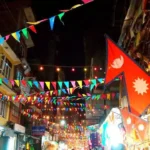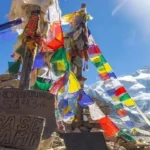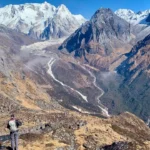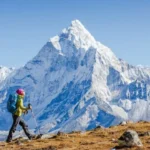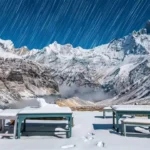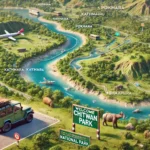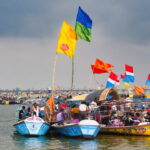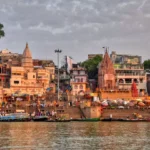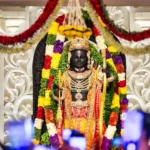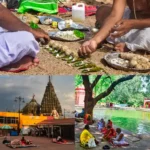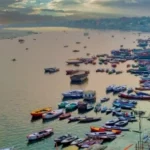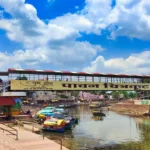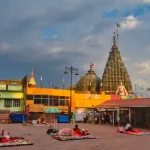Annapurna Circuit Trek Cost: Budgeting for Your Expedition
The total cost of the Annapurna Circuit Trek can vary significantly based on your travel style, duration, and whether you go with a guided tour or attempt it independently (if regulations allow). Here’s a breakdown of typical expenses (all figures are approximate and subject to change):
Trek Package (Guided Tour):
- Budget: $699 – USD 1,199 per person (includes basic teahouse accommodation, meals, permits, guide, sometimes porter, and local transport).
- Standard: $999 – $USD 1,999 per person (may include better accommodation, more meal options, private transport, and comprehensive insurance).
- Luxury: $2,499 – USD 3,999 per person (high-end lodges where available, enhanced services).
- International tour operators might charge $1,999 – $4,499.
Independent Trekking (if permitted):
- Accommodation: $5 – USD 15 per night for basic teahouses. Higher up, expect around $10-20 for twin-sharing rooms if you dine at the lodge.
- Food & Drinks: $25 – USD 40 per day.
- Breakfast: $8 – $12 (porridge, eggs, pancakes)
- Lunch/Dinner: $10 – $15 (Dal Bhat, noodles, momos, pasta)
- Tea/Coffee: $3 – $7
- Water: $1 – $2 per bottle (more at altitude; consider purification tablets/filter for cost efficiency and waste reduction).
- Permits: Approximately $40 – $USD 50(ACAP + TIMS).
- Guide (if required): $25 – $4USD 40er day.
- Porter (optional): $15 – $25USD 25r day.
- Porter-Guide (optional): $20 – USD 30 per day.
- Transportation: Kathmandu to Besisahar/Syange and Jomsom to Pokhara/Kathmandu. This can range from $20 for local buses to $100+ for private jeeps/flights.
- Equipment Rental/Buying: $150 – USD 300 (if you don’t own all the gear).
- International Flights: $600 – USD 1,200+.
- Travel Insurance: $100 – $USD 300(essential for covering medical emergencies and evacuation).
- Miscellaneous: Snacks, hot showers ($2-4), battery charging (may be extra), Wi-Fi (often extra), souvenirs, tips for guides/porters. Factor in an additional $100-$200 for these extras.
Cost-Saving Tips:
- Drink purified tap water instead of bottled water.
- Eat local Nepali dishes like Dal Bhat (often refillable).
- Share rooms where possible.
- Limit hot showers and charging devices at higher altitudes.
- Travel in the shoulder seasons (early March or late November) when demand is lower.
Guided vs. Independent Trekking: Annapurna Circuit Without a Guide?
Historically, the Annapurna Circuit was a popular choice for independent trekkers. However, as of April 1, 2023, Nepal introduced a new rule making it mandatory to hire a licensed guide or join a registered trekking agency for all treks within Nepal’s national parks and conservation areas, which includes the Annapurna Circuit.
While the regulation aims to enhance safety and provide employment for local guides, it’s wise to double-check the latest updates as policies can sometimes evolve.
If a guide is mandatory:
Benefits of a Guide:
- Safety: Guides are trained in first aid, navigation, and recognising signs of altitude sickness. They can assist in emergencies.
- Navigation: They know the trails well, including alternative routes to avoid dusty roads.
- Logistics: They handle teahouse bookings, communicate with locals, and help with permits.
- Cultural Insight: Guides offer invaluable insights into local culture, traditions, and the Himalayan environment.
- Pace Management: A good guide will ensure you acclimate properly by setting a sustainable pace.
- Support: They provide moral support and encouragement during challenging sections.

If independent trekking becomes permissible again (highly unlikely for now, but good to know):
Benefits of Independent Trekking:
- Flexibility: You set your own pace and itinerary, making spontaneous decisions.
- Cost-Effective: Eliminates guide/porter fees, reducing overall expenses.
- Self-Reliance: A sense of accomplishment from navigating and managing the trek entirely on your own.
Challenges of Independent Trekking:
- Safety Risks: Increased risk in case of an emergency, disorientation, or altitude sickness without expert assistance.
- Logistics: You manage all bookings, food, and communication.
- Navigation: Requires diligent map reading and awareness of alternative routes (NATT trails).
- Lack of Local Insight: Miss out on cultural nuances and local stories.
For the most up-to-date and reliable information regarding trekking regulations, it’s always best to consult with the Nepal Tourism Board or a reputable trekking agency in Nepal.
Annapurna Circuit Trek Itinerary: A Detailed Breakdown
The Annapurna Circuit Trek can be completed in various durations, typically ranging from 12 to 21 days, depending on your starting and ending points, side trips, and acclimatisation days. Here’s a common itinerary, with variations:
Typical Annapurna Circuit Trek Itinerary (12-21 Days)
This itinerary focuses on the core trek, often starting by driving further up the valley to avoid some of the road sections in the lower part.
- Day 1: Arrival in Kathmandu (1,400m / 4,593ft)
- Arrive at Tribhuvan International Airport (TIA), transfer to the hotel.
- Time for rest, gear check, and preparation.
- Day 2: Drive Kathmandu to Besisahar (760m / 2,493ft) / Syange (1,100m / 3,608ft)
- Scenic drive by bus or jeep through terraced fields and rural villages.
- Duration: 6-9 hours, depending on endpoint.
- Day 3: Trek to Dharapani (1,960m / 6,430ft) or Chame (2,710m / 8,891ft)
- If starting from Syange, trek through the forests and past waterfalls.
- If driving further (e.g., to Chame by 4WD), the trek formally begins from this point, offering views of Annapurna II and IV.
- Duration: 5-7 hours.
- Day 4: Trek to Pisang (Upper/Lower) (3,200m / 10,498ft)
- Continue ascending through pine forests, enjoying views of Annapurna II.
- Upper Pisang offers better views and a more traditional village experience.
- Duration: 5-6 hours.
- Day 5: Trek to Manang (3,540m / 11,614ft)
- A significant day with options: take the lower route (Ngawal) or the upper route (Ghyaru/Bhraka) for panoramic views. The upper route is more challenging but highly rewarding.
- Manang is a large, culturally rich village with good amenities.
- Duration: 6-7 hours.
- Day 6: Acclimatisation Day in Manang (3,540m / 11,614ft)
- Crucial for altitude acclimatisation.
- Options:
- Hike to Gangapurna Lake (short, easy).
- Hike to Ice Lake (Kicho Tal) (4,600m / 15,091ft) – challenging but excellent for acclimatisation.
- Visit the Himalayan Rescue Association (HRA) for a presentation on altitude sickness.
- Return to Manang for the overnight.
- Day 7: Trek to Yak Kharka (4,050m / 13,287ft) or Ledar (4,200m / 13,779ft)
- Gradual ascent, leaving the main Manang valley. The landscape becomes more arid and rocky.
- Duration: 4-5 hours.
- Day 8: Trek to Thorong Phedi (4,450m / 14,600ft) or High Camp (4,880m / 16,010ft)
- Continue ascending towards the pass. Staying at High Camp reduces the next day’s climb but means sleeping at a higher altitude. Thorong Phedi is a safer option for most.
- Duration: 3-4 hours.
- Day 9: Cross Thorong La Pass (5,416m / 17,769ft) and descend to Muktinath (3,800m / 12,467ft)
- The most challenging and rewarding day. Start early (pre-dawn) to cross the pass before strong winds pick up.
- Steep ascent to the pass, followed by a long, steep descent to Muktinath.
- Muktinath is a sacred pilgrimage site for Hindus and Buddhists.
- Duration: 8-10 hours.
- Day 10: Trek to Jomsom (2,720m / 8,924ft) or Kagbeni (2,804m / 9,199ft)
- Descend through the Kali Gandaki Gorge, one of the deepest gorges in the world. Often very windy.
- Jomsom is a larger town with an airport, offering flights to Pokhara. Kagbeni is a traditional Mustang village, more scenic than Jomsom.
- Duration: 3-5 hours.
- Day 11: Fly Jomsom to Pokhara (822m / 2,697ft)
- Day 12: Drive Pokhara to Kathmandu (1,400m / 4,593ft)
- Bus or flight back to Kathmandu, concluding your trek.
Variations and Extensions:
Optional Extensions: Tilicho Lake and Poon Hill
Tilicho Lake Side Trek: Adds 3-4 days to your itinerary.
- From Manang, detour to Shree Kharka, Tilicho Base Camp, and then an early morning hike to Tilicho Lake (4,920m / 16,140ft), one of the highest lakes in the world.
- This extension is challenging and exposed, requiring extra acclimatisation and gear. The views are spectacular.
Poon Hill Side Trek: Often done at the end of the circuit, extending from Tatopani.
- Instead of flying directly from Jomsom or taking a jeep, trek to Tatopani, then ascend to Ghorepani and Poon Hill (3,210m / 10,531ft) for a stunning sunrise view over the Annapurna and Dhaulagiri ranges.
- Adds 2-3 days to the trek.
These extensions provide more diverse experiences and further challenge. Discuss these options with your guide or agency when planning.

Accommodation and Food on the Annapurna Circuit
The Annapurna Circuit is a “teahouse trek,” meaning you’ll stay in local lodges that provide accommodation and meals.
Teahouse Trekking: Your Home in the Mountains
- Rooms: Teahouse rooms are typically basic, offering twin-sharing beds with mattresses, pillows, and blankets. Expect thin walls and no heating in the rooms. A good quality sleeping bag is highly recommended, especially for higher altitudes.
- Bathrooms: Lower down, some teahouses might have Western-style flush toilets and hot showers (often for an extra fee, usually $2-$4). As you ascend, facilities become more basic, with shared toilets and sometimes just a bucket of hot water for washing. Be prepared for squat toilets in some areas.
- Common Rooms: Most teahouses have a communal dining room or lounge area with a central stove (often yak dung or wood-fired) where trekkers gather to warm up, eat, and socialise. This is the social heart of the teahouse experience.
Important Note: Teahouse owners make their primary income from selling food and drinks, not accommodation. It’s an unwritten rule (and often a requirement) that you purchase your meals at the teahouse where you’re staying for the night.
Food on the Trail: Sustaining Your Journey
The food on the Annapurna Circuit is surprisingly varied and generally hearty, designed to fuel trekkers.
- Dal Bhat: The staple Nepali dish, consisting of lentil soup, rice, and vegetable curry (sometimes with meat). It’s a fantastic source of energy and often comes with free refills, making it the most economical and nutritious option.
- Other Options: Teahouse menus also offer a range of other dishes, including:
- Noodles: Thukpa (noodle soup), fried noodles, instant noodles.
- Pasta: Spaghetti, macaroni.
- Rice Dishes: Fried rice.
- Eggs: Omelettes, boiled eggs.
- Bread/Pancakes: Tibetan bread, chapati, pancakes.
- Soups: Garlic soup (believed to help with altitude sickness), vegetable soup.
- Momo: Nepali dumplings (vegetable or meat).
- Apple products: In Manang, you can find various apple dishes like apple strudel and apple pie.
- Drinks: Tea (black, milk, ginger, lemon honey), coffee (often instant), hot chocolate, soft drinks, and sometimes local beer. Hydration is key!
- Cost: As you ascend, the cost of food and drinks generally increases due to transportation difficulties.
Essential Services: Water, Electricity, and Wi-Fi
- Water: Bottled water is available, but it becomes expensive and contributes to plastic waste. Highly recommend carrying a water filter (e.g., Sawyer Squeeze, SteriPEN) or purification tablets. Many teahouses offer safe, filtered water for a small fee, or you can fill up from natural springs and purify it yourself. Aim to drink 3-4 litres per day.
- Electricity & Charging: Available in most teahouses, primarily through solar power at higher altitudes. Be prepared to pay a fee for charging your devices (phones, power banks, camera batteries). Power cuts can occur, so a fully charged power bank is invaluable.
- Wi-Fi/Internet: Available in many teahouses, especially in larger villages like Manang and Muktinath, but it’s often slow and comes with a fee. Don’t rely on it for critical communications. Consider buying a local Ncell or NTC SIM card in Kathmandu for better connectivity in some areas.
Staying Safe and Healthy on the Annapurna Circuit
Safety is paramount on any high-altitude trek. Here are crucial considerations for your Annapurna Circuit adventure.
Acclimatisation and Altitude Sickness Prevention
Acute Mountain Sickness (AMS), High Altitude Pulmonary Oedema (HAPE), and High Altitude Cerebral Oedema (HACE) are serious concerns on the Annapurna Circuit due to the significant altitude gain. Prevention is key:
- Gradual Ascent: The Annapurna Circuit’s counter-clockwise direction aids acclimatisation, as the ascent to Thorong La is more gradual. Avoid rapid ascents.
- Acclimatisation Days: Incorporate rest days, especially in Manang (3,540m). Use these days for short “climb high, sleep low” hikes to further aid acclimatisation.
- Hydration: Drink plenty of fluids (3-4 liters daily). Water, herbal tea, and soup are good. Avoid alcohol and excessive caffeine.
- Pace Yourself: Trek at a slow, steady pace. Listen to your body and don’t push yourself.
- Recognize Symptoms: Be aware of AMS symptoms: headache, nausea, dizziness, fatigue, loss of appetite, trouble sleeping. If symptoms worsen, descend immediately.
- Diamox: Consult your doctor about prophylactic use of Diamox (acetazolamide) to aid acclimatisation.
- No Pain, No Gain is Wrong: If you feel unwell, stop, rest, and consider descending. Ignoring symptoms can lead to severe and life-threatening conditions.

Essential Annapurna Circuit Trek Packing List
Packing smart is crucial for the Annapurna Circuit. Aim for lightweight, layered clothing.
Clothing:
- Base Layers: 2-3 pairs (thermal underwear – merino wool or synthetic).
- Mid-Layers: 2-3 fleece jackets/sweaters.
- Outer Shell: Waterproof and windproof jacket (Gore-Tex or similar).
- Down Jacket: Essential for cold evenings and high altitudes (a good quality, packable down jacket).
- Trekking Shirts: 4-7 breathable, quick-drying (synthetic or merino wool).
- Trekking Pants: 2-3 pairs (convertible or quick-drying).
- Thermal Leggings: For cold nights and high-altitude trekking.
- Socks: 5-6 pairs of warm hiking socks, plus sock liners.
- Underwear: Breathable, quick-drying.
- Gloves: Inner (fleece/thermal) and outer (waterproof/windproof) gloves.
- Hat: Warm beanie/wool hat and a sun hat/cap.
- Buff/Balaclava: For neck, face, and head protection.
Footwear:
- Trekking Boots: Broken-in, waterproof, ankle support.
- Camp Shoes/Sandals: For teahouse evenings.
- Flip-flops: For shared bathrooms.
Gear:
- Backpack: 50- 65L (if carrying your gear), 30- 40L (if using a porter). Ensure it has a rain cover.
- Sleeping Bag: 4-season (-10°C to -20°C comfort rating), essential for colder nights.
- Trekking Poles: Highly recommended for stability and reducing knee strain.
- Headlamp/Flashlight: With spare batteries.
- Water Bottles/Hydration Bladder: At least 2litress capacity.
- Water Purification: Filter bottle, SteriPEN, or purification tablets.
- Sunglasses: Dark, UV-protective.
- Sunscreen and Lip Balm: High SPF.
- Small Microfiber Towel: Quick-drying.
- First-Aid Kit: Band-Aids, antiseptic wipes, pain relievers, blister treatment, rehydration salts, altitude sickness medication (Diamox – prescribed by doctor), personal medications.
- Toiletry Bag: Toothbrush, toothpaste, biodegradable soap, hand sanitiser, wet wipes, toilet paper (bring your roll).
- Power Bank/Portable Charger: For devices.
- Camera and Spare Batteries: For capturing memories.
- Plastic Bags/Dry Sacks: For organising and keeping clothes dry.
Documents:
- Passport and photocopies.
- Permits (ACAP and TIMS).
- Passport-sized photos (extra for permits).
- Travel Insurance documents (with emergency evacuation coverage).
- Nepali Rupees (cash).
Health and Safety Tips
- Travel Insurance: Absolutely non-negotiable. Ensure it covers high-altitude trekking (up to 5,500m) and emergency helicopter evacuation.
- Hygiene: Practice good hand hygiene, especially before meals. Use hand sanitiser.
- Food Safety: Stick to freshly cooked meals. Avoid raw vegetables and unpeeled fruits unless you’ve washed them yourself.
- Stay on Marked Trails: Follow the designated Annapurna Circuit trails (look for red and white or blue and white markers for NATT trails).
- Inform Others: Let family or friends know your itinerary. If trekking solo (if allowed), register your plans with your embassy.
- Respect Local Culture: Dress modestly, especially in religious sites. Ask for permission before taking photos of people.
- Leave No Trace: Pack out everything you pack in. Dispose of waste responsibly.
Beyond the Trek: What to Expect Post-Annapurna Circuit
After completing the Annapurna Circuit, you’ll likely feel a mix of exhaustion and immense accomplishment. Many trekkers spend a day or two relaxing in Pokhara, enjoying its lakeside tranquillity, before returning to the hustle and bustle of Kathmandu.
- Pokhara: A popular tourist hub, Pokhara offers a more relaxed atmosphere than Kathmandu. You can enjoy boating on Phewa Lake, visiting Devi’s Fall, Gupteshwor Cave, and the World Peace Pagoda, or simply unwinding in its numerous cafes and restaurants.
- Kathmandu: Back in the capital, you might want to explore UNESCO World Heritage Sites like Pashupatinath Temple, Boudhanath Stupa, Swayambhunath (Monkey Temple), and the historic Durbar Squares. Thamel, the tourist district, is perfect for souvenir shopping and enjoying diverse cuisine.

Take time to reflect on your incredible journey. The Annapurna Circuit leaves a lasting impression, not just for its stunning landscapes but for the personal challenges overcome and the connections made along the way.









